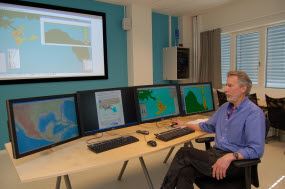
|
|
Research manager Mark Reed uses advanced computer based simulation tools in the project that SINTEF has been awarded by the US National Oceanic and Atmospheric Administration. Photo: Svein Tønseth |
“Soap” in the deep
The American authorities have decided to employ dispersants on the oil-slicks in the Gulf of Mexico. These soap-like chemicals break the oil down into tiny droplets that then become mixed into the water column, before the oil reaches the shore.
Most of the soap-like chemicals are released from aircraft flying over the oil-slicks on the surface.
However, the blow-out in the Gulf of Mexico is the first in which the cleanup teams are also injecting dispersant directly into the flow of oil and gas leaking out at the seabed. This is why the Americans contacted SINTEF.
“The US environmental authorities are demanding evidence that spraying at the seabed is not producing undesirably high concentrations of oil in the water column, as far as fish and other marine organisms are concerned. Our calculations show that the concentrations in the water column will not be significantly higher than they would have been without injection of dispersant at the wellhead,” says Reed.
Highly diluted
“What we see, in fact, is that the oil in the water column becomes highly diluted, because the volumes and depths involved are so great in this part of the ocean. The concentration of oil in the water column will be only slightly higher than it would have been in any case as a result of nature's own ability to break the oil-slicks down into droplets. Since the difference is so small, we do not believe that the use of dispersants in the water column in the Gulf has made matters worse for fish and other marine organisms,” says Reed.
Less oil on the beaches
According to the SINTEF scientist, it is more likely instead that the injection of dispersants at seabed level in this case has actually reduced the overall environmental impact of the spill.
“Our calculations show that the dispersants added at seabed level have prevented large amounts of oil from reaching the shore in the form of oil-slicks, with all that these would mean for birds, for example. The picture that we have arrived at via our calculations also matches observations of what has happened so far on the shores of the United States,” says Reed.
“What effects could such large quantities of dispersants deployed from aircraft have on the concentration of oil in the water column?”
“That question lies outside our remit, so we have not simulated their effects. The dispersants have probably increased the concentration of oil in the upper layers of the water column. Whether it will remain high will depend on the weather conditions. Strong winds will tend to dilute the concentration in the upper layers.”
Toxicity debate
“People are also claiming that dispersants are toxic. Are we at risk of solving one environmental problem by creating another?”
“It is true that on precautionary grounds we are wary of the widespread use of dispersant during periods when fish are spawning. But it is important to remember that modern dispersants are less toxic than oil. When the environmental effects of such measures are being evaluated, we cannot compare them with a situation in which an oil-spill has not occurred. As long as the oil continues to gush out of the well, we need to adopt the strategy that causes the least damage to the environment.”
Numerical model that looks into the water column
SINTEF was awarded its Gulf of Mexico contract by the National Oceanic and Atmospheric Administration (NOAA), which is an arm of the US Department of Commerce.
This is far from being the first time that the Trondheim scientists have been approached from afar to predict where oil-slicks are likely to end up. Mark Reed explains that SINTEF has developed a computer model that includes most aspects of how oil behaves in the wake of a spill.
“As far as we are aware, our simulation model is the best one available for calculating oil concentrations in the water column after a spill, which is why we were awarded the contract. Traditional models are only capable of predicting how oil-slicks will move on the surface,” he says.
Daily updates
The SINTEF estimates are updated every day.
“We predict both how much oil will reach the shore and what the concentrations in the water column will be, depending on the weather forecast and on whether dispersants are being used,” explains the research manager
Several previous projects
Mark Reed himself is a US citizen who came to SINTEF 18 years ago and is an expert on environmental modelling.
SINTEF's marine environmental technology group has almost forty staff. The department has previously used its numerical tools to model the behaviour of oil-spills off the coast of Kuwait after the first Gulf War, among other places, not to mention the wreck of the MV “Server” on Fedje near Bergen in 2007 and the grounding of the “Full City” bulk carrier off Langesund last summer, as well as the oil-spill on the Statfjord field in December 2007.
By Svein Tønseth
